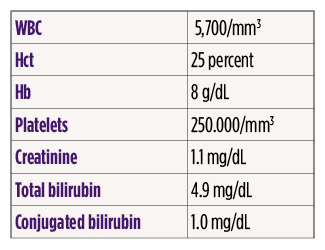If you’re preparing for the United States Medical Licensing Examination® (USMLE®) Step 1 exam, you might want to know which questions are most often missed by test takers. Check out this example from Kaplan Medical, and view an expert video explanation of the answer. Also check out all posts in this series.
This month’s stumper
A 22-year-old African immigrant presents to the hospital with acute abdominal pain. The pain is worst in the left-upper quadrant and is described as sharp. She has had this pain for the past several days. She has noticed these episodes frequently in the past but has chosen to ignore them until now. She has not seen a physician in many years, and her previous medical history is unknown. She is not taking any medications.
On physical examination, vital signs are: temperature, 98 °F (36.7 °C); heart rate, 102 beats per minute; blood pressure, 120/72 mm Hg, respiratory rate, 18 breaths per minute. Head and neck examination shows pale mucosa. Chest is clear to auscultation. Heart is tachycardic to auscultation and a loud systolic murmur is heard throughout the precordium. Pain is elicited upon palpation of the left-upper quadrant. Laboratory data are:
Chest radiography demonstrates no consolidation; however, the vertebrae are noted to be H-shaped. An ultrasound of the abdomen is performed, demonstrating a shrunken spleen and several gallstones without evidence of cholecystitis. Which of the following is the most likely composition of these gallstones?
A. Black pigment
B. Brown pigment
C. Calcium oxalate
D. Cholesterol
E. Uric acid
The correct answer is A.
Kaplan Medical explains why
This patient has sickle-cell anemia and is having an acute pain crisis. The clues in the vignette are the H-shaped vertebrae (caused by bone infarctions), the shrunken spleen and the unconjugated hyperbilirubinemia. Gallstone disease is common in patients with sickle-cell anemia, and the type of stones is black pigment stones composed of calcium bilirubinate. This is a consequence of excessive hemoglobin breakdown and incorporation into the bile. Precipitation of the breakdown pigments with calcium leads to black-pigment stone formation. Most sickle-cell patients are asymptomatic, and while cholecystectomy can be considered, these patients are at increased risk for postoperative complications.
Why the other answers are wrong
Read these explanations to understand the important rationale for why each answer is incorrect.
Choice B: Brown pigment stones are caused by chronic infection, often parasitic, of the biliary tree. These stones are composed of calcium salts of unconjugated bilirubin with small amounts of cholesterol and protein.
Choices C and E: Calcium oxalate and uric acid stones are most often associated with nephrolithiasis, not cholelithiasis.
Choice D: Cholesterol stones are the most common type of gallstones, accounting for approximately 80 – 85 percent of all gallstones. Women and obese individuals are predisposed to cholesterol gallstone formation.
One tip to remember
Conditions that cause chronic hemolysis, including sickle-cell anemia, predispose patients to the formation of black-pigment gallstones secondary to the biliary precipitation of excess hemoglobin breakdown products.
For more prep questions on USMLE Steps 1 and 2, view other posts in this series.




